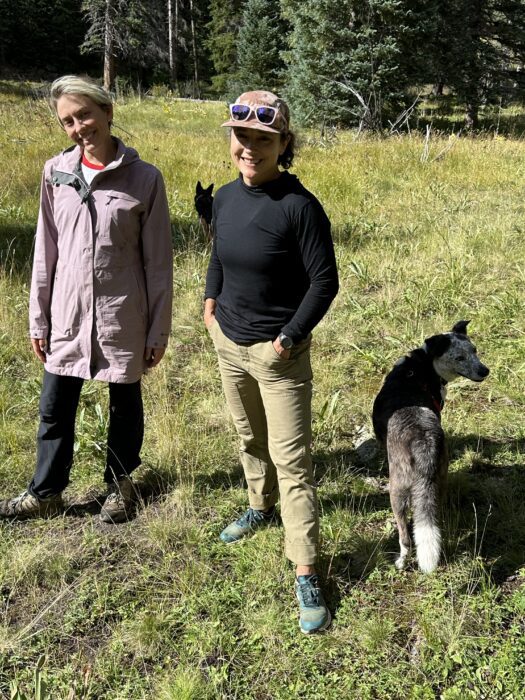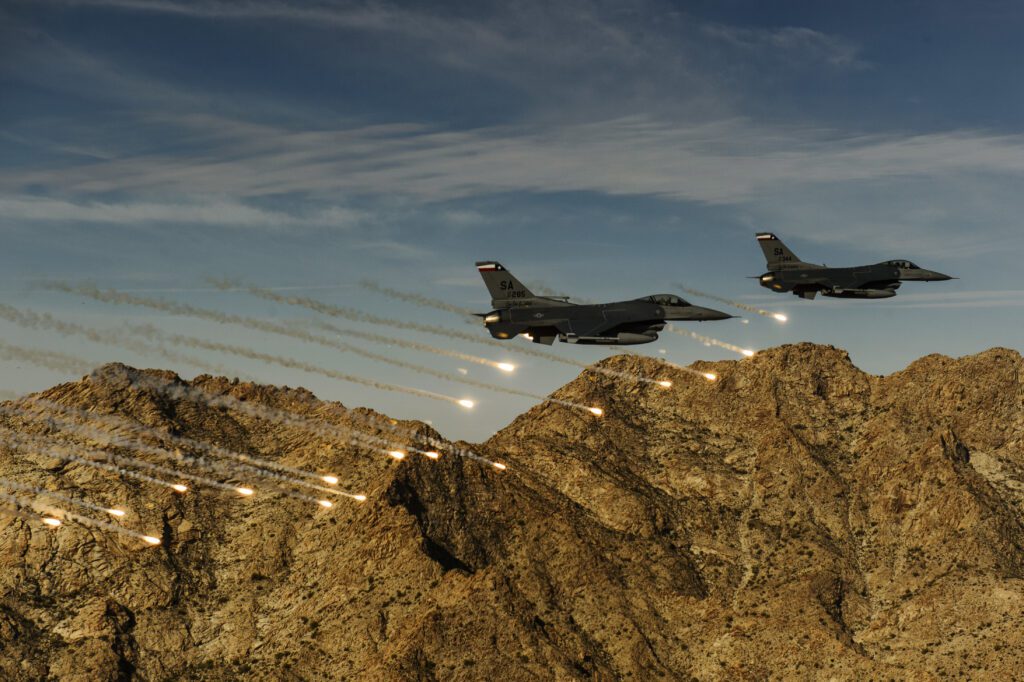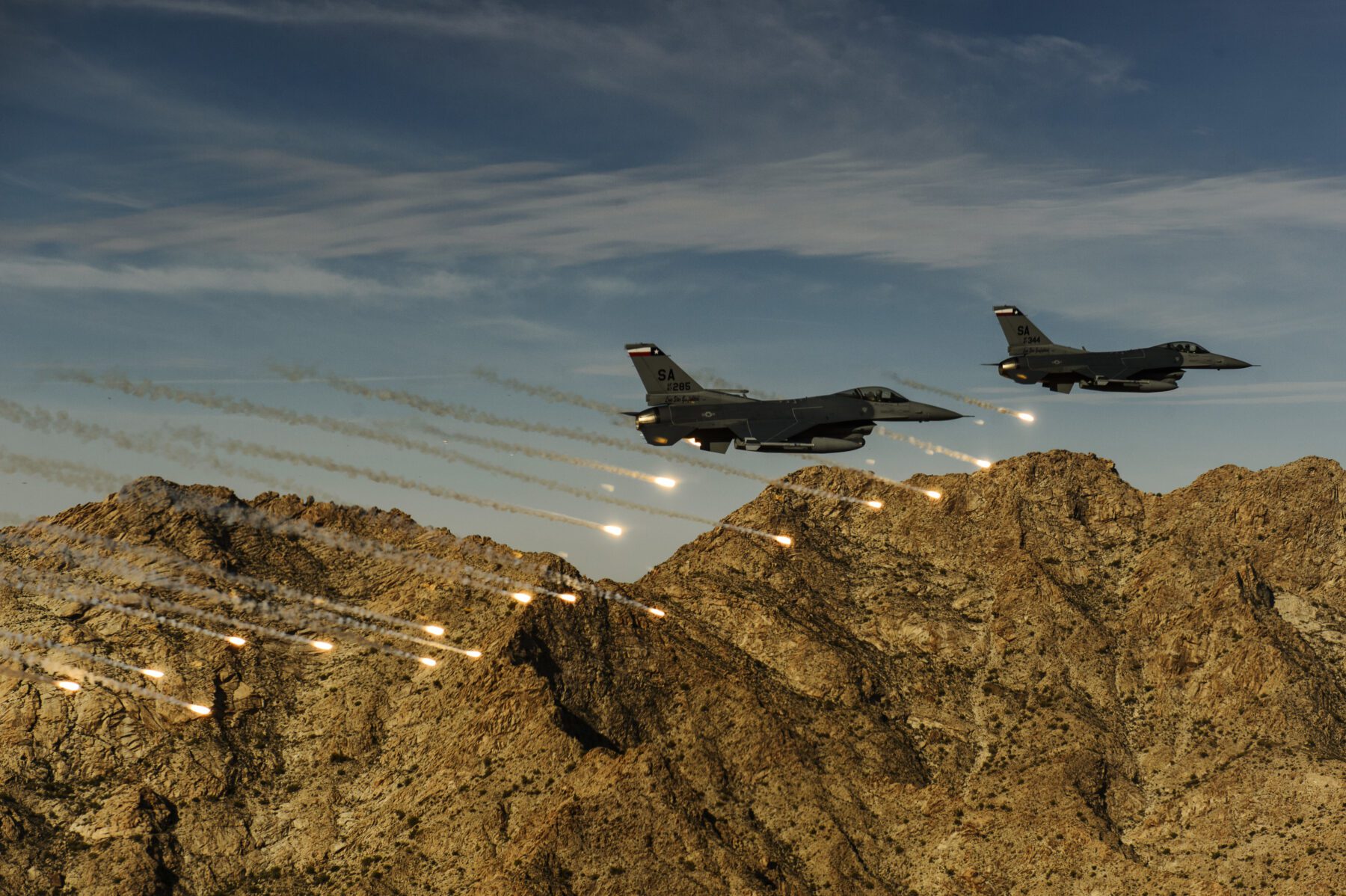
Erica Prather, Greater Gila Arizona Advocate, and Leia Barnett, Greater Gila New Mexico Advocate, with Ashes.
First, we heard the elk. Then the coyotes. Then the thunder and the rain. Then silence. Then the great horned owl. Then the elk again. At dawn we heard the dark-eyed juncos. Then the mountain chickadee. Then the mountain bluebird.
It was mid-September and community members traveled from Arizona and New Mexico to celebrate and revel in the beauty of Arizona’s White Mountains on the western boundary of the Greater Gila landscape. It was more than just a campout – members of the White Mountain Apache and Chiricahua Apache Tribes offered teachings about food sovereignty, traditional Apache fare, mushroom foraging, and Indigenous connections to the land. Though much of our time together was spent in the rain, sheltering from the storms that rumbled across the valleys, there was a deep sense of connection under that sacred open sky.
We spent the day wandering up the West Fork of the Little Colorado River, an early fall chill blushingthe aspen and the ferns into yellow and orange. At night we listened to a White Mountain Apache elder sing an ancient wolf warrior song, his drum beat clear, his strong voice echoing off the ponderosa pines. We ate traditional Apache acorn stew and listened to stories of lobos and corn harvests.

Wild Gila harvest.
This land, the Greater Gila, Nde Benah as it is known to the Apache, is sacred. It holds legacies and ancestral footprints, song lines and creation stories, the voices of our human and plant and animal cohabitants. All we have to do is listen.
But exploitation threatens the quiet vibrance of this place. Imagine how different our weekend would have been if our peaceful wanderings, teachings, and listenings were drowned out by the deafening roar of military aircraft performing low elevation combat training exercises blasting all other sound into oblivion. This will be the case if the United States Air Force is granted approval of their Special Use Optimization Strategy.
The threat
The U.S. Air Force is proposing low-level fighter jet maneuvers and supersonic flights over the Gila Wilderness and iconic Arizona landscapes, including the White Mountains, Organ Pipe Cactus National Park, sections of the Arizona Trail, and Arizona’s newest national park – Chiricahua. This proposal will impact millions of acres of federal public lands that sustainecosystems, water quality and wildlife, recreation and tourism. It will also affect dozens of rural and tribal communities, including the Tohono O’odham Nation, White Mountain and San Carlos Apache Nations, respectively and the Pascua Yaqui Tribe.

Wall Lake, Gila National Forest

Gila night sky (Photo by ByIan Beckley)
These overflights will cause sonic booms, which will shatter the area’s natural soundscape, stress wildlife, pets, and livestock, ruin the wilderness experience and qualities wilderness areas were set aside for, and threaten the well-being of local communities.
Alarmingly, the Air Force activities would release chaff and drop flares over fragile ecosystems, polluting the environment and increasing the risk of wildfires in a region under severe drought conditions exacerbated by worsening climate change. This proposal amounts to an attempt to turn an enormous swath of public, private, and Tribal lands in southwest New Mexico and southeast Arizona into a low elevation military training ground without regard to the economic, social, and cultural impacts on rural communities. Learn more about the U.S. Air Force proposal here.
We need your voice
Guardians, our partners and allies, and members of the New Mexico federal delegation are asking the Air Force to consider Option 1 of the Draft Environmental Impact Statement – no expanded military flyovers. We believe that the Air Force has enough land to conduct training in places like White Sands National Monument, the Barry Goldwater Range, and beyond. Our public and tribal lands have a higher value than serving as a military training ground.
But we need more support! The Air Force is accepting comments on the DEIS through October 9th. Please submit a comment of your own to voice your opinion on their proposal. The more specific and concise the better. Having more individuals share their own opinions is important. To help you, we have drafted some suggested comment language below.
Make your voice heard. Submit comments today.
SAMPLE LANGUAGE FOR AIR FORCE DEIS COMMENTS
- The DEIS ignores the social and cultural impacts to tribal communities who will disproportionately experience the negative impacts from this proposal. Tribal communities were overlooked during the scoping period and the DEIS comment period and are absent from any of the Public Hearing locations. Three tribes, the Tohono O’odham Nation, White Mountain Apache Tribe, and San Carlos Apache Tribe, bear a disproportionate burden from the proposal since five (5) of the MOAs are directly above millions of miles of Tribal lands and the impacts are so significant.
- The DEIS fails to offer a compelling reason why expanding low altitude combat training and lowering supersonic flight levels is warranted, given it states the Barry M Goldwater Range (BMGR) could provide all of its training needs with the addition of weekend scheduling. This is a much safer alternative than submitting dozens of communities and millions of acres of protected lands to significant increases in combat training sorties. The DEIS eliminates this alternative, shifts risks of low altitude combat training from the safer option – the BMGR – to rural and tribal communities who are unprepared for accidents and emergencies. The Air Force should reconsider the use of BMGR in the EIS.
- The DEIS minimizes the cumulative risk of fire from the substantial increase in the number of flares drops permitted. References and data regarding these risks is outdated and dismisses known cases of fire caused by military training, and ignores the rising threat of climate enhanced fires across the Desert Southwest. Communities and land agencies, ill-equipped to deal with large scale fire emergencies, are assigned to primary responsibility for crash response. No realistic plans for fighting a flare or crash fire are included in the plan.
- The DEIS dismisses possible impacts on the dozens of endangered and threatened species-particularly those with critical habitat below the airspace. The analysis does not adequately project the impacts of the increasing frequency of low-level jet flight on animal behavior- and thereby fails to consider the incremental and cumulative effects on these species – as is required by EIS regulations. The DEIS neglected to include NM Game and Fish as a consulting agency.
- The DEIS acknowledges that lowering the flight floor of supersonic jet flight to 5,000 ft (AGL) will increase the sonic boom pressure five-fold. But the flawed analysis concludes there will be no increase in negative impacts, despite the increasing evidence nationwide of broken car windshields, cracked foundations and dozens of recorded evidence of damaged houses. The Air Force should restrict low level supersonic flight to existing training grounds more suited for that level of risk.
- The DEIS minimizes the effect on regional airspace needs within the developing civil aviation community.
- The Air Force has not responded to requests for information on the need for this proposed training expansion (a.k.a. optimization) and has been unresponsive to existing noise and disturbance complaints from communities below their airspace.
Make your voice heard. Submit comments today.
“Counties across New Mexico have opposed the expansion, with Grant, Catron and Hidalgo counties passing resolutions opposing the proposal. Vasquez is calling for the Air Force to limit these operations to the Barry M. Goldwater Range (BMGR) in Arizona, where combat training already occurs.” – Congressman Gabe Vasquez

Two F-16C Fighting Falcons release flares while conducting low-level combat training during the Coronet Cactus exercise near Davis-Monthan Air Force Base, Ariz. The F-16s are assigned to the 182nd Fighter Squadron. This exercise provides realistic combat training for student fighter pilots from air-to-air combat to dropping inert and live ordnance. (U.S. Air Force photo/Staff Sgt. Jonathan Snyder/3rd Combat Camera Squadron)
